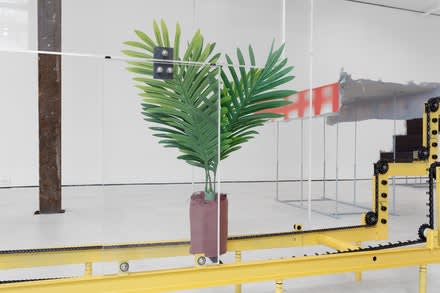The sculptor Dorian Gaudin has been making a name for himself with kinetic installations that combine Alexander Calder’s economy of form and Jean Tinguely’s gearbox aesthetic, teasing viewers with the stirrings of what seem like autonomous machines. For Example, his disquieting 2016 exhibition at Nathalie Karg Gallery, Jettison Parkway, contained an imposing, 9-foot-wide aluminum cylinder whose constellation of visible internal gears propelled it back and forth across the gallery in wobbly, unpredictable lurches. His jittery 2017 Rites & Aftermath—a solo exhibition at the Palais de Tokyo—centered around a 36-foot-long steel sheet that resembled a conveyor belt and whose gradual expansions and contractions set off sporadic chain reactions among the metallic chairs and apparatuses positioned around the room. Gaudin’s kinetic works have the teasing, slow-motion drama of a Samuel Beckett play, in which, because so little changes from moment to moment, tiny plot developments produce outsized effects. In other words, as in a Beckett play, the action’s apparent pointlessness is part of its point.
The centerpiece of Gaudin’s current exhibition at Nathalie Karg is an eponymous, 25-foot-long installation (2018) constructed out of two parallel tracks of interlocking steel I-beams, spaced a foot apart from one another, evoking a jungle gym, a roller coaster, and an assembly line all at once. Painted warm yellow, the I-beams have been bolted together to form stepped, rectilinear circuits. A long gear chain, like that of a bicycle, runs along each I-beam track as a quietly droning motor inches the chains along the tracks. In two places, a flat metal bar has been affixed to both chains and is then used as the base for a sculptural object—a fiberglass disposable coffee cup; a fiberglass flower pot containing a synthetic palm plant—that completes droll, unhurried loops around the machine. How viewers understand the sculptures’ surrealistic procession—whether a jokey critique or eccentric embrace of technological monotony—depends ,in part, on how they construe the installation’s suggestively ambiguous title. The “spring” in The coffee cup spring could be read as an ironic verb or an ingenuous noun.
Read the full article here




